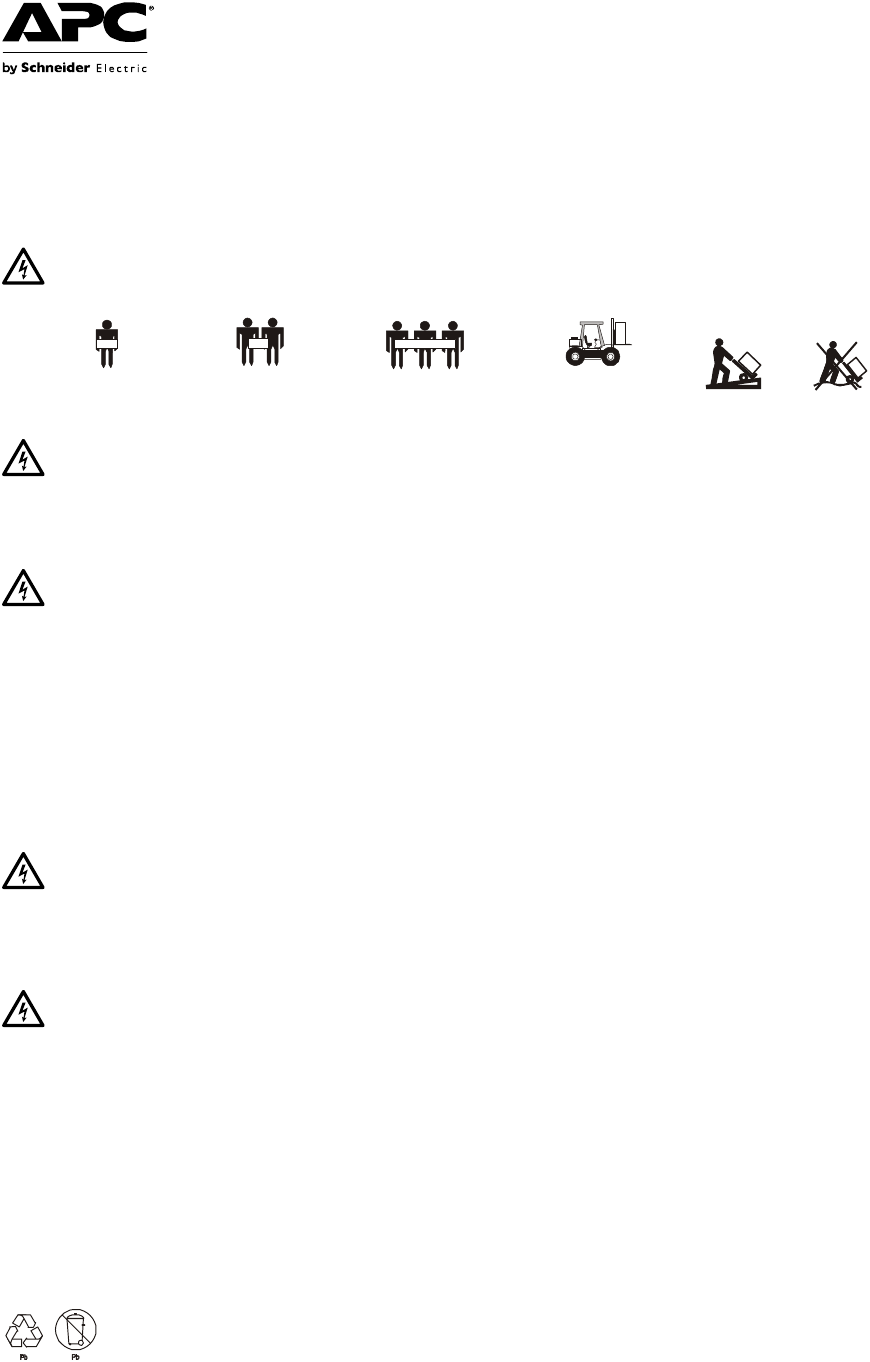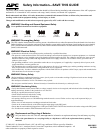
© 2009 APC
®
by Schneider Electric. APC, the APC logo, and Smart-UPS are owned by Schneider
Electric Industries S.A.S., American Power Conversion Corporation, or their affiliated companies. All
other trademarks are property of their respective owners.
990-2902C
04/2009
Safety Information—SAVE THIS GUIDE
This Safety Guide contains important instructions that should be followed during installation and maintenance of the APC equipment
and batteries. It is intended for APC customers who setup, install, relocate, or maintain APC equipment.
Read, understand, and follow ALL safety instructions contained in this manual. Failure to follow safety instructions and
warnings could result in equipment damage, serious injury, or death.
Changes and modifications to this unit not expressly approved by APC could void the warranty.
WARNING! Handling and General Equipment Safety
Use a qualified electrician to hardwire equipment.
WARNING! De-energizing Safety
The UPS contains internal batteries and may present a shock hazard even when disconnected from the branch circuit (mains).
Before installing or servicing the equipment, check that the system enable switch and input circuit breaker are set to stand-by
(OFF), that the internal batteries are removed, that external extended run batteries are disconnected and the branch circuit
(mains) is disconnected.
WARNING! Electrical Safety
• Connection to the branch circuit (mains) must be performed by a qualified electrician.
• The protective earth conductor for the UPS carries the leakage current from the load devices (computer equipment). An insulated
ground conductor is to be installed as part of the branch circuit that supplies the UPS. The conductor must have the same size and
insulation material as the grounded and ungrounded branch-circuit supply conductors. The conductor will be green and with or
without a yellow stripe.
• The grounding conductor is to be grounded to earth at the service equipment, or if supplied by a separately derived system, at the
supply transformer or motor-generator set.
• The attachment-plug receptacles near the unit or subsystem are all to be of a grounding type, and the grounding conductors serving
these receptacles are to be connected to earth ground at the service equipment.
• 230 V models only: In order to maintain compliance with the EMC directive for products sold in Europe, output cords attached to the
UPS should not exceed 10 meters in length.
WARNING! Battery Safety
• Before installing or replacing the batteries, remove jewelry such as wristwatches and rings. High short-circuit current through
conductive materials could cause severe burns.
• Do not dispose of batteries in a fire. The batteries may explode.
• Do not open or mutilate batteries. Released electrolyte is harmful to the skin and eyes, and may be toxic.
WARNING! Hardwiring Safety
• Verify that all branch circuit (mains) and low-voltage (control) circuits are de-energized, and locked out before installing cables or
making connections, whether in the junction box or to the UPS.
• Wiring by a qualified electrician is required.
• Check national and local codes before wiring.
• Strain relief is required for all hardwiring.
• All openings allowing access to UPS hardwiring terminals must be covered. Failure to do so may result in personal injury or
equipment damage.
• Select wire size and connectors according to national and local codes.
• Loads can be connected directly to the UPS using the output plugs on the PDU panel.
• Ensure that the total load being plugged into a PDU panel DOES NOT EXCEED the branch circuit breaker rating on the PDU panel.
• Use flexible metal conduit to make maintenance and service easier.
Replacement and Recycling of Batteries
See your dealer or the APC Web site, www.apc.com for information on replacement battery kits and battery recycling.
Deliver the spent batteries to a recycling facility or ship them to APC in the replacement battery packing
material.
<18 kg
(<40 lb)
18-32 kg
(40-70 lb)
32-55 kg
(70-120 lb)
>55 kg
(>120 lb)



